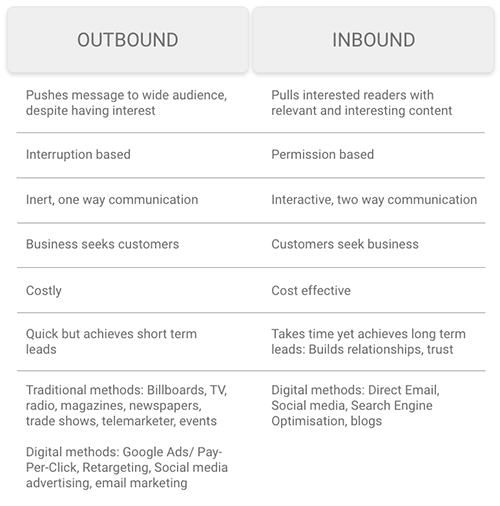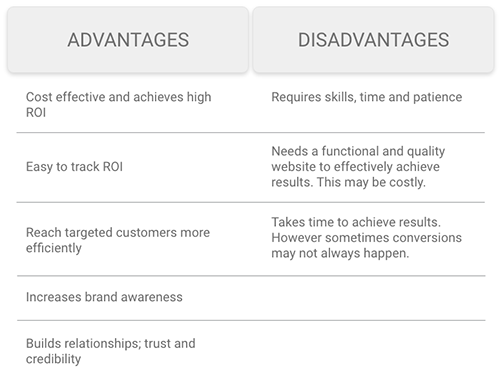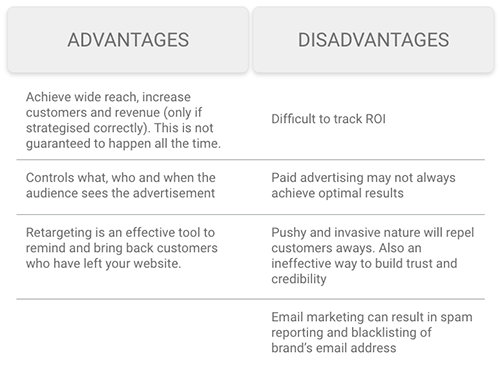Once upon a time, traditional Outbound Marketing interrupted the daily lives of consumers with billboard, television, radio and newspaper advertisements. Today, it’s a different story with Inbound Marketing.
In the past decade, technology and the Internet have transformed the way companies market their brands, shifting from outbound to inbound strategies. Acquiring new customers no longer mean sitting at a trade show, hoping potential customers will walk past and fill out their details on your form. Nor does it mean sitting at your table for hours to end, cold-calling profusely to get your customer’s contact details.
Truth is, consumers are no longer paying attention to the ad bombardments around them due to the growing abundance of information on the internet. This shows that consumer’s buying behaviour has changed dramatically. They are being more selective with what they want to know and what they want to ignore.
If you want to survive and succeed in this digital paradigm, you will need to first understand the differences between inbound and outbound marketing, choose the right marketing strategies for your business and implement them to prioritize your time on running your business while achieving off-the-charts results.
But first things first, what is outbound and inbound marketing.
Outbound Marketing
Outbound Marketing is also known as the traditional way of marketing that many of us have grown up with: print adverts, billboards, radio, TV, magazines, newspapers, direct email, cold calling etc. It is a more proactive, invasive and disruptive form of marketing that pushes itself at a wider audience regardless of them wanting it or not.
Due to this nature, outbound marketing is generally quite frowned upon by consumers, who will normally ignore or reject the message being advertised. However, we should not completely disregard outbound marketing. When strategized correctly, outbound marketing can also generate great results. These include digital outbound methods such as Google Ads/ PPC (pay per click ads), retargeting ads, email marketing, Facebook Ads and events.
Inbound Marketing
On the other hand, Inbound Marketing is the new marketing concept that uses interesting and relevant content to attract leads to your website. This involves creating content on your website, blogs, social media, email newsletters, white paper etc for your targeted audience to read. It is a more interactive and indirect form of marketing that can naturally pull inbound traffic to your website, which you can then convert, close and delight over time.
“Your number-one job is to tell your story to the consumer wherever they are, and preferably at the moment they are deciding to make a purchase.” – Gary Vaynerchuk
Not only does inbound marketing target the right people, it is also permission-based, meaning it requires consent to receive marketing communication. Although It is a long-term play that requires you to be patient and creative with your content, inbound marketing is more effective and natural in converting your leads into customers as you build a relationship with them over time.
What are the Differences Between Inbound and Outbound Marketing?
There are many differences between Inbound and Outbound Marketing. Here are some fundamental differences you should be aware of.

Inbound vs. Outbound: Pros and Cons
Both Inbound and Outbound Marketing have different advantages and disadvantages. Here are the pros and cons for both marketing concepts you need to consider.
Inbound Marketing

Outbound Marketing

So Inbound or Outbound? Which One Should I Choose?
Although inbound marketing may be an optimal strategy in today’s digital landscape, inbound marketing may not be the right solution for every business. It really depends on who your audience is and your business’ needs. If your business can afford paid advertising, we recommend utilizing both inbound and digital outbound strategies to support each other’s incompetencies in producing results. Inbound is a long-term play that will achieve trust and credibility in customers, while outbound can reach an audience quickly when done correctly.
To achieve optimal results, small businesses need to first understand its customers and their personas, their needs and wants, how your product and service can solve their problem and differentiate from your competitors, and of course, a functional quality website to drive web traffic through your inbound and outbound marketing strategies.
Hope this post has helped you understand the importance and differences between inbound and outbound marketing strategies. Remember to always learn and try new things. Technology and innovation are constantly evolving; what worked last year might not work this year. You target audience may also change as consumers change what they want and what they need through time. The most important strategy in business is to experiment, analyze, celebrate, and repeat.
Hope you have enjoyed and gained an insight from this article. Join our Netstripes community on Facebook, Instagram and LinkedIn and stay up to date with the newest marketing trends, tips and events.

Crucial digital marketing insights and strategies for the ‘new normal’
Futurise Insights are a suite of FREE power-packed webinars designed for small and mid-sized businesses struggling with innovation and growth.



